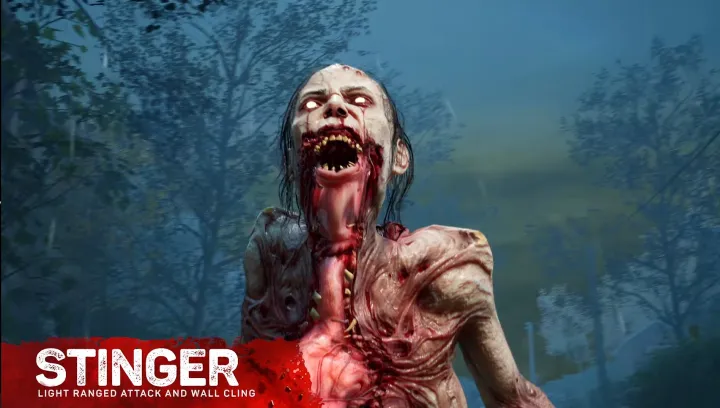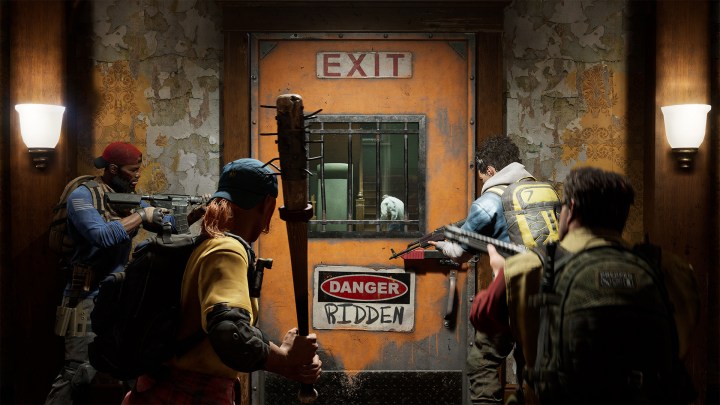The Left 4 Dead games were marketed primarily as co-operative survival experiences. The main focus was clearly on designing a fun experience for players and their friends to work together in fighting off the swarms of the undead. The multiplayer component that put players in the role of both the human characters and the special zombie types turned out to be a simple yet surprisingly fun addition. Back 4 Blood, the spiritual sequel to those original zombie shooters by the same team, is back with its new-and-improved take on PvP in a zombie shooter.
Playing as a human in the campaign mode is very simple for most gamers to get a grip on. Aside from the nuances, it is a co-operative FPS that plays as you would expect. In the PvP mode, however, half the time, you’ll be taking control of those special Ridden types you fight off during the campaign. Not only is it a major change to go from the standard FPS controls to a zombie, but each of the Ridden types also has its own abilities and best strategy. You’ll need to master all the Ridden types, as well as the humans, to win in Back 4 Blood‘s PvP mode, so we’ve collected all the best tips you need to dominate.
Further reading
- A beginner’s guide to Back 4 Blood: How to fight back against the horde
- Back 4 Blood’s card system explained
- Back 4 Blood crossplay
What is the PvP mode, and how does it work?

The single PvP mode in Back 4 Blood, at least for now, is called Swarm mode. While Left 4 Dead games simply added four players to spawn as special infected in the normal campaign missions, this time, matches are all about surviving for as long as possible rather than making it through the level. Swarm mode works in rounds of three, with whichever team wins two first being the victors. Each round alternates which team plays as the humans and which hunts them as the Ridden. The goal of the Cleaners is to simply survive for as long as possible, while the Ridden obviously want to eliminate them as fast as possible. Whichever team of Cleaners sets the longer survival time wins that round.
The Swarm for which the mode is named functions just like a storm in a battle royale game. This cloud of infected bugs will close in as the match goes on, shrinking the area the Cleaners have and slowly tipping the scales more and more in the Ridden’s favor. It also makes sure rounds can’t go on indefinitely.
Before a round properly starts, each team has a chance to prepare. The Cleaners will pick their character as well as one of the set PvP cards from a deck that will give you a buff, with a new one added each round. Next, you and your team will be placed on the map in a preparation phase before the Ridden onslaught begins. You have some time here to loot some crates, get yourself loaded with weapons, and put down defenses like traps and barbed wire.
If you’re on the Ridden team, you also have some pre-game tasks to take care of. Instead of cards to pick, Ridden will use things called Mutation Points to upgrade either themselves or the basic A.I.-controlled Ridden on the map. Ridden players will earn points by dealing damage to the Cleaners during the match and will be able to continue to spend points and get stronger during the course of the entire round. Your other task is to choose which of the special Ridden types you want to play as from the three choices available, each of which has three classes. There’s the Stinger, Reeker, and Tallboy.
Once the round starts, it’s a race for the Ridden to kill the entire Cleaner team as fast as possible while the Cleaners try and, well, survive as long as possible. Cleaners don’t respawn while the team playing as the Ridden will keep coming back after a brief respawn timer until the Cleaners eventually perish.
Tips for playing as the Ridden

Unlike the PvP modes in Left 4 Dead where you are randomly assigned one of the special infected to play as each time you spawn, in Back 4 Blood you get the choice of which Ridden you want to control. You’ll be familiar with them from fighting them in the campaign missions, but actually controlling them is a very different experience. Here’s how each of the three types, and their respective subclasses, work.
Stinger
The Stinger is a small, nimble, and generally low-health Ridden type. Every type has the standard Leap ability to move around the map and escape danger, making all types great at distracting and chipping away at the Cleaners’ health. Because they’re not very tanky, you don’t want to rush in or initiate an attack on your own.
The Stinger type is the only one of the three that can’t restrain Cleaners in any way. Instead, this version has a projectile to damage Cleaners from a distance. This version can be very annoying and great to play if you like taking potshots and leaping away so your team can take advantage of you splitting their attention.
Hockers also have a projectile, but rather than dealing raw damage, it functions more like a disgusting trap. Any Cleaner hit by this gooey mass will get caught and trapped in the mess, leaving them open for you, or your team, to deal free damage until another Cleaner comes to free them. However, this goo doesn’t last forever, so a Cleaner will eventually break free on their own, and because you’re able to do it from a distance, this move has a pretty long cooldown timer.
Finally, we have the Stalker. This version can pin down Cleaners too but has to get up close and personal to do it. Their grab move is very reminiscent of the Jockey from Left 4 Dead 2, where you can steer your prey in whatever direction you want once you’ve jumped on them, as well as deal damage all the while. This is a highly risky move, but if done at the right time, can pull a team apart and allow your team to get a ton of damage in on one Cleaner at a time.
Reeker

Reekers are bigger and far slower than Stingers. They want to get right in close to the enemy for melee and kamikaze-style effects, again calling back to a Boomer from Left 4 Dead. Like that class, Reekers will limit the vision of any Cleaner that is too close when it’s killed, as well as attract more of the common infected to attack them. They all come with a basic rush ability to get into the middle of a group and hopefully explode right in the enemy’s face.
The basic Reeker type is melee-centered and has the nice benefit of not having a weak point like the others. They’re something like a tank, rushing in and dealing damage with their charge, taking as many melee hits as they can get, and then exploding on as many Cleaners as possible.
Speaking of exploding, the Exploder is built to die, but in a good way. The best way to utilize this specific class of Reeker is in ambush situations where you take Cleaners by surprise right up in their faces so they kill you before realizing how bad an idea that is. You can still charge into them like any other variant, but it’s obviously riskier.
Last up is the Retch. This class is part Boomer, as with the entire Reeker type, but mixed with the Spitter. It can vomit like a Boomer, but the vomit isn’t used to attract other infected but leaves a damaging pool like the Spitter would. This class is best kept far away and sniping key areas with acid to prevent Cleaners from helping each other.
Tallboy

Tallboys may be the most popular Ridden type because of how action-focused they are. While slow, they can pack a serious punch if you’re able to get into close range. Every type has a dash to help close distances, plus the highest base health of any Ridden. However, that makes them a clear target for Cleaners, so despite their tanky nature, you probably won’t get far rushing a team alone.
Your regular Tallboy gets a bit more distance on their sprint ability than the others and deals a little more damage. Really, they’re your more generic, balanced Tallboy type.
Crushers are the only Tallboy type that can restrain a Cleaner by using their big arm to grab a Cleaner and crush them for damage over time, plus opening them up to damage from other infected while they’re unable to escape. Crushers do have an obvious weak point right on their front, so if a team notices you coming, you’re in a bad spot.
And Bruisers are the real tanks of the team. They have the most health of any Ridden but at the cost of how far you’re able to sprint with your ability. You’ll want to play similar to the Exploder and set yourself up in spots where you can quickly initiate an attack without giving the Cleaners much time to zone you out and chip your health away, and make your big AOE slam attack most effective.
After picking your Ridden, the main point to keep in mind when playing this team is how you spend your Mutation Points. You have four options for dumping your points, one for each of the three Ridden classes, and one for the common Ridden. Upgrading one Ridden class does upgrade all three of the variants within, but you should still invest in the common infected, too. These little guys may be cannon fodder at first, but over time will be constant pressure on the Cleaners.
Second, don’t just spend points on whatever class you’re playing. Your upgrades are not just yours but shared across the entire team. That means if your teammate is just a few Mutation Points away from an upgrade with their class, you can invest some into it to push them over the edge, and vice versa. Spread the love and invest as a team, not an individual.
Tips for playing as the Cleaners

Cleaners don’t need as much explanation since they function just like they do in normal campaign missions. The difference here is that rather than trying to make it through an area to the next saferoom, you and your team just need to hold out for as long as possible. After picking your cards, you get a few moments to scavenge the map before the Ridden come at you.
The two obvious points are to stay together as a team at all times and avoid the Swarm. Going off on your own, just like in the campaign, is the fastest way to get picked off by the other team, either forcing your team to risk saving you or going on with one less player. Communication is just as important in this mode as in the campaign mode.
Don’t bunker yourselves down in a tight area. Many Ridden have AOE attacks, like the slam and acid vomit, that make clumping up a bad idea. You will also want to be free to move around and collect resources as the match goes on, so give your team a little breathing room to move around in. Likewise, make sure at least someone has a stun gun on your team for when a Ridden either rushes in close or pins one of your teammates. Freeing your teammate from any form of incapacitation should be priority No. 1.
Finally, keep an eye on that Swarm. As it closes in, it will be easier and easier for you to accidentally get too close or for Ridden to actually knock you into it. Do your best to position your squad in areas where you can’t easily be hit into damage. At the same time, there are areas on maps that act as environmental hazards even worse than the Swarm since they act as instant death, like water. Stay clear of these spots at all costs.
As far as team composition goes, no Cleaner is going to be useless or even bad in PvP but there are some that you will want to have on your team.
Mom has an extra life and a quick revive that is perfect for squeaking out just a bit more time for your team.
Doc is great for the free heal he can give all members of his team, allowing you to save up resources like healing items.
And an EvANGELo is another great class due his ability to get out of pins on his own. That doesn’t mean you should go wild and go out on your own, but it does mean one less thing your team will have to worry about.



